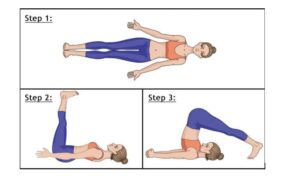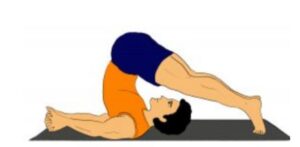Introduction to Halasana
Halasana is an inverted yoga pose. The word derives from the Sanskrit language. The word Hala means plow and asana mean yogic posture (Ramesh, 2019). Another name of Halasana is Plow pose. This name is derived from the shape of the pose, that resembles the shape of plows.

Figure: Steps of Halasana
Things to remember before practicing Halasana
Women during pregnancy should avoid trying this asana. It is also instructed that the persons suffering from cardiac problems should also avoid this yoga (Thulasi, et al., 2019). To get proper results, the practitioners should regularly practice this yoga without giving any interruptions. The yoga instructors suggest that after practicing the yoga, the practitioners should not take bath or have food immediately. While practicing yoga, the practitioners are strictly instructed to inhale and exhale only through the nose, not from the mouth, and should hold their breath (Ramesh, 2019). This exercise is not for beginners and the practitioners should have good communication between their mind and body before practicing yoga. Practicing this pose seems to be very difficult for people with tight and stringent hamstrings. To avoid this problem, the practitioners can sometimes bend their knees.
Good sides of doing this pose

Yoga involves stretching the back muscles. By giving a good stretch in the nerves of the spinal cord region, it helps in strengthening the back muscles. Regular practice of this yoga helps in improving the digestion process and making the metabolism activities smooth and faster (Ramesh, 2019). The yoga instructors suggest that this yoga helps in strengthening the liver muscles and helps in better blood flow, which further helps in making the human body active. Halasana can even improve the hormonal fluctuations, thus can eradicate the problems related to infertility (Thulasi, et al., 2019). Practicing Halasana regularly helps the practitioners to gain a better immune system.
Mistakes, frequently done by the practitioners
Sometimes, individuals suffering from neck and back injuries practice this yoga, without knowing the consequences, as a result of which it gives rise to severe back pains and injuries (Thulasi, et al., 2019). Individuals often put more pressure on the neck and head, which causes headaches. Practicing this yoga immediately after waking up from sleep also creates problems in the back muscles, as our body remains less flexible after waking up (Ramesh, 2019). When the practitioners pull the shoulders too far from their ears, it can suppress the throat and can give rise to suffocations.
References
Ramesh, S. (2019). TimeLine Practice of Yoga on the Level of Depression. Indian Journal of Public Health Research & Development, 10(7). Retrieved from https://web.s.ebscohost.com/abstract?direct=true&profile=ehost&scope=site&authtype=crawler&jrnl=09760245&AN=138553442&h=291Uq1dn0y3aiZ90hA5Q5uC1Qzn3jOwyY0G4g6O9vVA8epOLslHKWCkaXh49IHAQA1uqKCJm0a7Z1DHWwnDsUw%3d%3d&crl=c&resultNs=AdminWebAuth&resultLocal=Er
Thulasi, A., Kumar, V., Jagannathan, A., Angadi, P., Umamaheswar, K., & Raghuram, N. (2019). Development and Validation of Yoga Program for Patients with Type 2 Diabetes Mellitus (T2DM). Journal of religion and health, 1-15. Retrieved from https://link.springer.com/article/10.1007%2Fs10943-019-00859-x